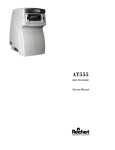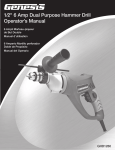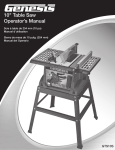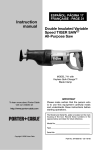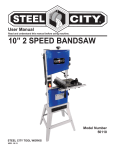Download 5.5 Amp VS Reciprocating Saw Operator`s Manual
Transcript
5.5 Amp VS Reciprocating Saw Operator’s Manual Scie alternative à vitesse variable 5,5 A Manuel d’utilisation Sierra de vaivén con velocidad variable de 5.5 amperios Manual del Operario ARS55 ARS55 English 5.5 Amp VS Reciprocating Saw ARS55 Operator’s Manual Specifications: • • • • • • Model: Input: No-Load Speed: Stroke Length: Net Weight: Blade Type: ARS55 120V AC, 5.5 Amp. 600-2,500 RPM 1-1/16" 7.0 lbs. 1/2" Shank Warning: To reduce the risk of injury, user must read and understand this operator’s manual before operating this tool. Save this Manual for future reference. Toll-Free Help Line: 1-888-552-8665. wear your Safety glasses Warning: The Operation of any power tool can result in foreign objects being thrown into your eyes, which can result in severe eye damage. Before beginning tool operation, always wear safety foresight is better goggles or safety glasses with side shields and a full face shield Than no sight when needed. We recommend Wide Vision Safety Mask for use over eyeglasses or standard safety glasses with side shields. Always wear eye protection which is marked to comply with ANSI Z87.1. Look for this symbol to point out important safety precautions. It means attention!!! Your safety is involved. 2 5.5 Amp Variable Speed Reciprocating Saw Operators Manual ARS55 Warning: Some dust created by power sanding, sawing, grinding, drilling, and other construction activities contains chemicals known to cause cancer, birth defects or other reproductive harm. Some examples of these chemicals are: • lead from lead-based paints, • crystalline silica from bricks and cement and other masonry products, and • arsenic and chromium from chemically treated lumber. English GENERAL SAFETY RULES Your risk from these exposures varies, depending on how often you do this type of work. To reduce your exposure to these chemicals: work in a well ventilated area, and work with approved safety equipment, such as those dust masks that are specially designed to filter out microscopic particles. Warning: READ AND UNDERSTAND ALL WARNINGS, CAUTIONS AND OPERATING INSTRUCTIONS BEFORE USING THIS EQUIPMENT. Failure to follow all instructions listed below may result in electric shock, fire and/or serious personal injury. SAVE THESE INSTRUCTIONS 1. READ THE INSTRUCTION MANUAL BEFORE OPERATING THE MACHINE. To minimize the possible occurrence of accidents and personal injury, learn the tool’s application, limitations, and specific potential hazards peculiar to this tool. 2. WEAR EYE AND HEARING PROTECTION. ALWAYS USE SAFETY GLASSES WITH SIDE SHIELDS. Unless otherwise specified, everyday glasses provide only limited impact resistance, they are NOT safety glasses. Use only certified safety equipment; eye protection equipment should comply with ANSI Z87.1 standards. Protective hearing equipment should comply with ANSI S3.19 standards. 3. DO NOT USE THIS OR ANY OTHER MACHINE WHEN YOU ARE TIRED, UNDER THE INFLUENCE OF DRUGS, ALCOHOL, OR MEDICATION. WATCH WHAT YOU ARE DOING, STAY ALERT AND USE COMMON SENSE. 4. WEAR PROPER CLOTHING. Do not wear loose clothing, gloves, neckties, rings, bracelets, wrist watches or other jewelry which may get caught in moving parts. Wearing nonskid footwear is recommended as well as wearing protective hair covering to contain long hair. 3 English 5. USE AND KEEP GUARDS IN PLACE and in good working order. Never operate the machine with any guard or cover removed. Check that all guards are in place, secured, and working correctly before each use to reduce the risk of injury. 6. DO NOT USE THE TOOL IN DANGEROUS ENVIRONMENTS. Keep the work area well lighted to prevent tripping or inadvertently placing arms, hands,or fingers in dangerous positions. Do not use power tools in damp or wet locations or in the rain which can cause shock or electrocution. 7. KEEP THE WORK AREA CLEAN. Cluttered areas and benches invite accidents. 8. CHECK THE TOOL FOR DAMAGED PARTS before using the machine. Check for proper alignment of moving parts, binding of moving parts, component breakage, and any other conditions that may affect the tool’s operation. A guard or any other part that is damaged must be properly repaired or replaced by an authorized service center to avoid risk of personal injury. 9. REMOVE ADJUSTING KEYS AND WRENCHES BEFORE STARTING THE TOOL. Keys, wrenches, scrap, and other debris can be thrown at high speed, possibly causing serious personal injury. 10.KEEP CHILDREN AND VISITORS AWAY. Your shop is a potentially dangerous environment and visitors should not be allowed to contact any tools, extension cords, or roam about unsupervised. All visitors should wear safety glasses and be kept a safe distance from the work area. 11.MAKE THE WORKSHOP CHILDPROOF by using padlocks, master switches, and by removing starter keys from tools. 12.MAINTAIN ALL TOOLS AND MACHINES WITH CARE. Keep tools sharp and clean for best and safest performance. Follow instructions for lubricating and changing accessories. 13.DISCONNECT TOOLS WHEN NOT IN USE, before servicing, or when changing attachments, blades, bits, cutters, etc. 14.REDUCE THE RISK OF UNINTENTIONAL STARTING. Check to be sure that the tool’s switch is in the “OFF” position before plugging in the power cord. Should a power failure occur, move the switch to the “OFF” position. Accidental start-ups can cause serious personal injury. 15.USE THE CORRECT TOOL FOR THE JOB. Don’t force the tool or attachment to do a job for which it was not designed. Don’t use the tool for a purpose not intended as damage to the machine and/or personal injury may result. 4 5.5 Amp Variable Speed Reciprocating Saw Operators Manual ARS55 17.MAKE SURE YOUR EXTENSION CORD IS THE PROPER SIZE AND IS IN GOOD CONDITION. When using an extension cord, be sure to use one heavy enough to carry the current your product will draw. An undersized cord will cause a drop in line voltage resulting in loss of power and tool overheating. Consult the Extension Cord Chart for the correct size based on the cord length and nameplate ampere rating. If ever in doubt, use the next heavier wire gauge cord. The smaller the gauge number, the heavier the cord. English 16.USE RECOMMENDED ACCESSORIES. Using accessories and attachments not recommended by the manufacturer or intended for use on this type tool, may cause damage to the machine or result in personal injury to the user. Consult the instruction manual for recommended accessories. 18.SECURE THE WORK-PIECE. Use clamps or a vise to hold the work-piece when practical. Using clamps or similar mechanical device is safer than using your hand(s) and allows you to use both hands to operate the tool. Losing control of the work-piece can cause personal injury. 19.DON’T OVERREACH. Maintain proper footing and balance at all times; loss of balance can cause you to fall into the working machine, possibly causing an injury. 20.NEVER STAND ON THE TOOL. An injury may occur if the machine is tipped or if you should unintentionally contact the cutting tool. 21.DO NOT FORCE THE TOOL. The tool will perform the job better and safer at the feed rate for which it was designed. Forcing the tool could possibly damage the machine and may result in personal injury. 22.FEED THE WORK-PIECE IN THE CORRECT DIRECTION AND SPEED. Feed the work-piece into a blade, cutter, or abrasive surface against the direction of the cutting tool’s direction of rotation only. Incorrectly feeding the work-piece in the same direction as the cutting tool rotates causes the work-piece to be thrown out at high speed. 23.NEVER LEAVE THE TOOL RUNNING UNATTENDED. TURN THE POWER OFF. Don’t leave the machine until it comes to a complete stop. 24.TURN THE MACHINE “OFF”, AND DISCONNECT THE MACHINE FROM THE POWER SOURCE before adjusting or changing set-ups, or when making repairs. An accidental start-up may occur causing personal injury. 25.NEVER USE THE TOOL IN AN EXPLOSIVE ATMOSPHERE. Normal sparking of the motor could ignite fumes. 26.KEEP THE TOOL DRY, CLEAN, AND FREE FROM OIL AND GREASE. Always use a clean cloth when cleaning. Never use brake fluids, gasoline, petroleum-based products, or any solvents to clean the tool. 5 English 27.DO NOT USE THE TOOL IF SWITCH DOES NOT TURN IT ON AND OFF. Have defective switches replaced by an authorized service center. 28.USE ONLY CORRECT BLADES. Do not use blades with incorrectly sized arbor holes. Never use blade washers or blade bolts that are defective or incorrect. 29.BEFORE MAKING A CUT, BE SURE ALL ADJUSTMENTS ARE SECURE. DOUBLE CHECK ALL SETUPS. Make sure the blade is tight and not making contact with the saw or work-piece before connecting to the power supply. 30.AVOID CUTTING NAILS. Inspect for and remove all nails from lumber before cutting. 31.NEVER TOUCH THE BLADE OR OTHER MOVING PARTS DURING USE. 32.NEVER START A TOOL WHEN ANY ROTATING COMPONENT IS IN CONTACT WITH THE WORK-PIECE. 33.MAKE SURE THE WORK AREA HAS AMPLE LIGHTING to see the work and that no obstructions will interfere with safe operation BEFORE performing any work. 34.INSPECT TOOL CORDS PERIODICALLY. If a damaged cord is found, have it repaired by a qualified service technician at an authorized service facility. The conductor with insulation having an outer surface that is green with or without yellow stripes is the equipment-grounding conductor. If repair or replacement of the electric cord or plug is required, do not connect the equipment-grounding conductor to a live terminal. Repair/replace damaged or worn cords immediately. Be constantly aware of the cord location and keep it well away from the rotating blade. 35.POLARIZED PLUGS. To reduce the risk of electric shock, this tool has a polarized plug (one blade is wider than the other). This plug will fit in a polarized outlet only one way. If the plug does not fit fully in the outlet, reverse the plug. If it still does not fit, contact a qualified electrician to install the proper outlet. Do not change the plug in any way. Warning: USE OF THIS TOOL CAN GENERATE AND DISBURSE DUST OR OTHER AIRBORNE PARTICLES, INCLUDING WOOD DUST, CRYSTALLINE SILICA DUST AND ASBESTOS. Direct particles away from face and body. Always operate tool in a well ventilated area and provide for proper dust removal. Use dust collection system wherever possible. Exposure to the dust may cause serious and permanent respiratory or other injury, including silicosis (a serious lung disease), cancer, and death. Avoid breathing the dust, and avoid prolonged contact with the dust. Allowing dust to get into your mouth or eyes, or lay on your 6 5.5 Amp Variable Speed Reciprocating Saw Operators Manual ARS55 English skin may promote absorption of harmful material. Always use properly fitting NIOSH/OSHA approved respiratory protection appropriate for dust exposure, and wash exposed areas with soap and water. EXTENSION CORDS Grounded tools require a three wire extension cord. Double insulated tools can use either a two or three wire extension cord. As the distance from the power supply outlet increases, you must use a heavier gauge extension cord. Using extension cords with inadequately sized wire causes a serious drop in voltage, resulting in loss of power and possible tool damage. Refer to the table shown below to determine the required minimum wire size. The smaller the gauge number of the wire, the greater the capacity of the cord. For example: a 14 gauge cord can carry a higher current than a 16 gauge cord. When using more than one extension cord to make up the total length, be sure each cord contains at least the minimum wire size required. If you are using one extension cord for more than one tool, add the nameplate amperes and use the sum to determine the required minimum wire size. Guidelines for Using Extension Cords • If you are using an extension cord outdoors, be sure it is marked with the suffix “W-A” (“W” in Canada) to indicate that it is acceptable for outdoor use. • Be sure your extension cord is properly wired and in good electrical condition. Always replace a damaged extension cord or have it repaired by a qualified person before using it. • Protect your extension cords from sharp objects, excessive heat, and damp or wet areas. Recommended Minimum Wire Gauge for Extension Cords (120 Volt) Nameplate Amperes (At Full Load) Extension Cord Length 25 Feet 50 Feet 75 Feet 100 Feet 150 Feet 200 Feet 0–2.0 18 18 18 18 16 16 2.1–3.4 18 18 18 16 14 14 3.5–5.0 18 18 16 14 12 12 5.1 –7.0 18 16 14 12 12 10 7.1–12.0 18 14 12 10 8 8 12.1–16.0 14 12 10 10 8 6 16.1–20.0 12 10 8 8 6 6 7 English SPECIFIC SAFETY RULES FOR RECIPROCATING SAWS Warning: DO NOT allow familiarity with the Reciprocating Saw from repeated use replace strictly following all operating rules. If the tool is used unsafely or incorrectly, you or a bystander can suffer serious personal injury! Warning: Hold tool by insulated gripping surfaces when performing an operation where cutting tools may contact hidden wiring or its own cord. Contact with a “live” wire will make exposed metal parts of the tool “live” and shock the operator! 1. Always wear safety glasses or goggles. Normal prescription eye or sunglasses are not safety glasses. 2. Hold the Reciprocating Saw by its insulated gripping surfaces to avoid electrical shock from unseen “live” wires. 3. Always hold the tool firmly. DO NOT leave the tool running unless hand held. 4. Check your work area for proper clearances before cutting. This will avoid cutting into your workbench, the floor, etc. 5. Do not cut oversized work pieces. 6. DO NOT cut nails or screws unless you are using a blade specifically designed for this purpose. Inspect your material before cutting. 7. Before switching on the tool, be sure the blade is not contacting the workpiece. 8. Keep hands away from moving parts and on the top surface of the workpiece. Do not place hands below work surface while saw is operating. 9. Always allow the blade to completely stop before removing from the workpiece. Do not touch the blade, it is hot and may cause a serious burn. OPERATION Warning: Always check that the power supply corresponds to the voltage on the rating name plate. Warning: To avoid accidental start, check to make sure Lock-on button is not engaged prior to plugging in tool and your finger is not touching the on/off switch. Tool Uses This tool is designed to cut wood, metal, plastic, and composites. 8 5.5 Amp Variable Speed Reciprocating Saw Operators Manual ARS55 Depth of Cut Adjustment The Front Shoe can be adjusted to change the depth of cut of your reciprocating saw. To adjust the depth of cut, loosen the Front Shoe Locking Screws (located on the bottom of the Saw Boot) by inserting the provided allen wrench and rotating counter-clockwise. Set your depth of cut (Note: ideal depth of cut is 1” deeper than material to be cut), then tighten the Front Shoe Locking Nut securely. English Installing the Blade Check that the blade you are inserting matches the material you are cutting. Start with a sharp blade. Twist the quick release blade clamp as far as it will go in the direction of the engraved arrow (counterclockwise if facing the saw). Slip new blade into blade clamp as far as it will go. Release the blade clamp. The new blade should now be securely fastened. Turning the Tool On To turn the tool on, depress the on/off switch. The tool can be locked on by depressing the lock-on button and the on/off switch at the same time, then releasing pressure on the on/off switch. Caution – The lock-on feature is to relieve fatigue on the trigger finger only. Grip tool firmly at all times while it is running, and keep both hands away from cutting area. To release the lock-on button, depress the on/off switch. Using Variable Speed Adjust the speed by dialing the Variable Speed thumb roller. Speed use guidelines are as follows, however, the operator may have to vary the speed to optimize cutting efficiency: Slower Speeds: starting cuts, plastics, soft aluminum, some stainless steel Faster Speeds: aluminum, mild steel, stainless steel, various woods Cutting Action The reciprocating saw blade is doing most of its cutting as it travels towards the operator. Depending on the type of material and cutting speed, this can cause splintering on the surface of the workpiece that is facing the operator. Therefore, if possible, position yourself or the workpiece so that the desired “good” side of the workpiece is facing away from the operator. General Cutting Clamp your workpiece if it is portable. Rest the front shoe of the saw on your workpiece (be sure the blade is not contacting the workpiece) and start the saw. Start the cut, exerting enough pressure in the direction of the cut to keep the blade cutting, and enough forward pressure to keep the shoe pressed firmly against the workpiece at all times. Do not force the cut or stall the saw. Don’t bend or twist the blade. Let the tool and the blade do the work. In general, coarser blades are for wood, plastics, and composites, and finer blades are for cutting metal. Chattering or vibration may indicate you need a finer blade or higher speed. If the blade overheats or clogs, it may indicate you need a coarser blade or slower speed setting. Replace blades when they become dull. Dull blades will produce poor results and may overheat the saw. 9 English Metal Cutting Blades specifically designated for cutting metals must be used for this purpose. You may use a light oil as a coolant when cutting metal; this will prevent overheating of the blade, help the blade cut faster, and promote longer blade life. Warning: Wear safety glasses. Wear a dust mask if operation is dusty. Wear hearing protection during long periods of operation. Support and clamp work piece securely. Keep your balance and don’t overreach. 1. Adjustable, Pivoting Shoe 2. Rubberized non-slip Boot 3. Rubberized non- slip Rear Handle 4. Tool-less Blade Change System 5. Variable Speed Thumb Dial 6. Trigger Switch 7. Lock-On Button 5 7 6 3 2 4 1 Two-Year Warranty This product is warranted free from defects in material and workmanship for 2 years after date of purchase. This limited warranty does not cover normal wear and tear nor damage from neglect or accident. The original purchaser is covered by this warranty and it is not transferable. Please return the tool to store location of purchase along with your receipt, and you will receive a new drill or a refund. THIS PRODUCT IS NOT WARRANTED IF USED FOR INDUSTRIAL OR COMMERCIAL PURPOSES. 10 Toll-Free Help Line: For questions about this or any other APPRENTICE Product please call Toll-Free: 888-552-8665. 5.5 Amp Variable Speed Reciprocating Saw Operators Manual ARS55










